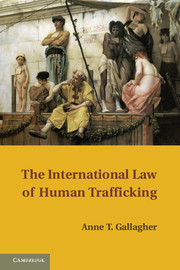Book contents
- Frontmatter
- Contents
- Preface
- Table of Cases
- Table of Treaties and Other International Instruments
- Table of Common Abbreviations
- THE INTERNATIONAL LAW OF HUMAN TRAFFICKING
- Introduction
- 1 The International Legal Definition
- 2 The International Legal Framework
- 3 Specific Legal Issues
- 4 State Responsibility for Trafficking
- 5 Obligations of Protection and Support
- 6 Obligations Related to Repatriation and Remedies
- 7 Obligations of an Effective Criminal Justice Response
- 8 Obligations to Prevent Trafficking and Respond Lawfully
- 9 Issues of Compliance, Implementation, and Effectiveness
- Epilogue
- Select Bibliography
- Index
- Frontmatter
- Contents
- Preface
- Table of Cases
- Table of Treaties and Other International Instruments
- Table of Common Abbreviations
- THE INTERNATIONAL LAW OF HUMAN TRAFFICKING
- Introduction
- 1 The International Legal Definition
- 2 The International Legal Framework
- 3 Specific Legal Issues
- 4 State Responsibility for Trafficking
- 5 Obligations of Protection and Support
- 6 Obligations Related to Repatriation and Remedies
- 7 Obligations of an Effective Criminal Justice Response
- 8 Obligations to Prevent Trafficking and Respond Lawfully
- 9 Issues of Compliance, Implementation, and Effectiveness
- Epilogue
- Select Bibliography
- Index
Summary
In January 2010, the European Court of Human Rights found that Cyprus and Russia had incurred international legal responsibility with respect to the death, in Cyprus, of a Russian national and probable victim of trafficking, and that they were therefore liable in damages. Although the victim's death and likely exploitation were not attributed to Cyprus or Russia, both States were held to have violated related human rights obligations, specifically through failure to regulate employment and through inaction in the face of private conduct. These violations arose through failure to carry out an effective investigation into the death (including securing the relevant evidence from overseas as well as domestically, and investigating whether there had been any trafficking-related corruption); failure to ensure that the migration regime itself afforded protection against trafficking; and failure to investigate trafficking. The Court held that “national legislation must be adequate to ensure the practical and effective protection of the rights of victims or potential victims of trafficking.” It explained that in addition to criminal law measures to punish traffickers, Member States are also required to “put in place adequate measures regulating businesses often used as a cover for human trafficking,” and to ensure their immigration rules “address relevant concerns relating to encouragement, facilitation or tolerance of trafficking.” In reaching its decision, the Court went beyond the European Convention on Human Rights to examine the provisions of a range of specialist instruments including the Trafficking Protocol, the European Trafficking Convention, and the European Convention on Mutual Assistance in Criminal Matters.
- Type
- Chapter
- Information
- The International Law of Human Trafficking , pp. 499 - 504Publisher: Cambridge University PressPrint publication year: 2010

